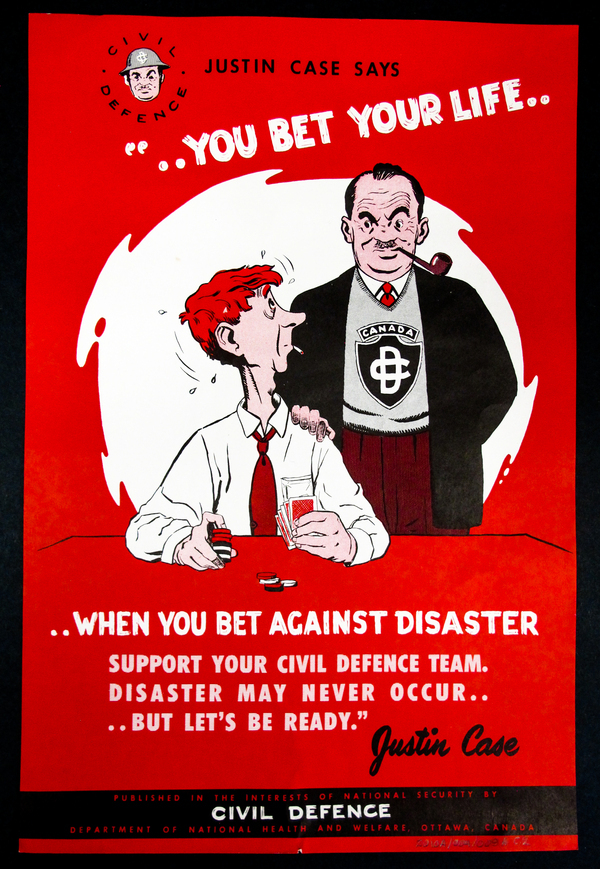Cold War Civil Defence
During the early Cold War (1948-1962), the Canadian government once again turned to propaganda posters to communicate how civilians might support the war effort. These campaigns, however, were not designed to recruit soldiers or raise funds; rather, they were aimed to solicit participation in civil defence activities. Blurring the boundaries between military and civilian spheres of life, civil defence engages citizens on the home front of the battlefield. Distinct from previous wars fought internationally by troops at a distance, the Cold War brought the battlefield home via the threat of nuclear attack. Though Canada was technically at peace after the Armistice of 1945, growing ideological tensions between the United States and the USSR made war an imminently perceived peril. This culture of fear was intensified through the development of nuclear technology which changed the nature of warfare and sparked widespread anxiety. Cold War civil defence therefore aimed to quell these worries by providing practical training in preparation for, and optimistically survival from, nuclear devastation.
In 1948, the Canadian government created Civil Defence Canada to develop, organize, and promote civil defence activities. Initially determined to be under the jurisdiction of the Department of National Defence, retired Major-General F.F. Worthington was chosen as the lead advisor. By 1950, Worthington had developed the country’s initial approach which, perhaps surprisingly, did not center fallout shelters.[6] The degree to which a nuclear attack was considered survivable changed as technologies evolved and the impacts of nuclear devastation were better understood.[7] In its early stages, civil defence strategies drew on those developed by the United Kingdom during the Blitz, sometimes referred to as a “self-help” model of defence.[8] Self-help did not mean that Canadians were completely on their own. Rather, it implied the involvement of civilians in their own defence activities which were part of a coordinated military response, including the logistics and infrastructure of survival. These efforts involved a wide variety of activities including coordinated evacuation plans, emergency first response, and skills preparation such as firefighting. Such large-scale planning, however, required government support, which was not forthcoming.[9] In 1951, the Department of National Defence argued that civil defence fell outside of their mandate and it was consequently shuttled to the Department of National Health and Welfare.[10] At this point it was becoming increasing clear that in order to even get close to the volunteer recruitment numbers required, publicity materials were necessary. One element of this publicity campaign was the development of a civil defence education campaign featuring a series of propaganda posters. Developed by the Internal Services Division of the Department of National Health and Welfare during the mid-1950s, the Canadian poster campaign featured the cartoon mascots of civil defence, Bea Alerte and Justin Case [Figure 2].
References
6 Andrew Burtch, Give Me Shelter: The Failure of Canada’s Cold War Civil Defence (Vancouver: UBC Press, 2012), 156.
7 Laura McEnaney, Civil Defense Begins as Home: Militarization Meets Everyday Life in the Fifties (Princeton: Princeton University Press, 2000), 41
8 Burtch, 1.
9 This issue is illustrated in this article detailing an interview between Worthington and a reporter in 1951: “Speed Up Civil Defence or Kill It- Worthington,” The Gazette (Montreal, QC), Aug. 30, 1951, https://www.newspapers.com/image/419738283/.
10 Burtch, 41
